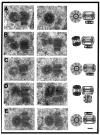Anomalous centriole configurations are detected in Drosophila wing disc cells upon Cdk1 inactivation
- PMID: 12456723
- PMCID: PMC2754245
- DOI: 10.1242/jcs.00204
Anomalous centriole configurations are detected in Drosophila wing disc cells upon Cdk1 inactivation
Abstract
The centriole, organizer of the centrosome, duplicates by assembling a unique daughter identical to itself in overall organization and length. The centriole is a cylindrical structure composed of nine sets of microtubules and is thus predicted to have nine-fold symmetry. During duplication, a daughter lacking discrete microtubular organization first appears off the wall of the mother centriole. It increases in length perpendicularly away from the mother and terminates growth when it matches the length of the mother. How a unique daughter of the correct length and overall organization is assembled is unknown. Here, we describe three types of unusual centriole configurations observed in wing imaginal discs of Drosophila following inactivation of Cdk1. First, we observed centriole triplets consisting of one mother and two daughters, which suggested that centrioles have more than one potential site for the assembly of daughters. Second, we observed centriole triplets comprising a grandmother, mother and daughter, which suggested that subsequent centriole duplication cycles do not require separation of mother and daughter centrioles. Finally, we observed centriole pairs in which the daughter is longer than its mother. These findings suggest that regulatory events rather than rigid structural constraints dictate features of the stereotyped duplication program of centrioles.
Figures





Similar articles
-
9-fold symmetry is not essential for centriole elongation and formation of new centriole-like structures.Nat Commun. 2024 May 25;15(1):4467. doi: 10.1038/s41467-024-48831-y. Nat Commun. 2024. PMID: 38796459 Free PMC article.
-
The developing Drosophila eye - a new model to study centriole reduction.J Cell Sci. 2018 Feb 22;131(4):jcs211441. doi: 10.1242/jcs.211441. J Cell Sci. 2018. PMID: 29361550
-
Cdk1 Phosphorylates Drosophila Sas-4 to Recruit Polo to Daughter Centrioles and Convert Them to Centrosomes.Dev Cell. 2016 Jun 20;37(6):545-57. doi: 10.1016/j.devcel.2016.05.022. Dev Cell. 2016. PMID: 27326932 Free PMC article.
-
Centriole duplication: analogue control in a digital age.Cell Biol Int. 2010 Dec;34(12):1239-45. doi: 10.1042/CBI20100612. Cell Biol Int. 2010. PMID: 21067522 Free PMC article. Review.
-
Emerging insights into symmetry breaking in centriole duplication: updated view on centriole duplication theory.Curr Opin Struct Biol. 2021 Feb;66:8-14. doi: 10.1016/j.sbi.2020.08.005. Epub 2020 Sep 18. Curr Opin Struct Biol. 2021. PMID: 32956908 Review.
Cited by
-
Centrosomal nucleolin is required for microtubule network organization.Cell Cycle. 2015;14(6):902-19. doi: 10.1080/15384101.2014.1000197. Cell Cycle. 2015. PMID: 25590348 Free PMC article.
-
CDK1 Prevents Unscheduled PLK4-STIL Complex Assembly in Centriole Biogenesis.Curr Biol. 2016 May 9;26(9):1127-37. doi: 10.1016/j.cub.2016.03.055. Epub 2016 Apr 21. Curr Biol. 2016. PMID: 27112295 Free PMC article.
-
Licensing of yeast centrosome duplication requires phosphoregulation of sfi1.PLoS Genet. 2014 Oct 23;10(10):e1004666. doi: 10.1371/journal.pgen.1004666. eCollection 2014 Oct. PLoS Genet. 2014. PMID: 25340401 Free PMC article.
-
Daughter centriole elongation is controlled by proteolysis.Mol Biol Cell. 2010 Nov 15;21(22):3942-51. doi: 10.1091/mbc.E09-12-1049. Epub 2010 Sep 22. Mol Biol Cell. 2010. PMID: 20861314 Free PMC article.
-
Overexpressing centriole-replication proteins in vivo induces centriole overduplication and de novo formation.Curr Biol. 2007 May 15;17(10):834-43. doi: 10.1016/j.cub.2007.04.036. Epub 2007 May 3. Curr Biol. 2007. PMID: 17475495 Free PMC article.
References
-
- Alberts B, Bray D, Lewis J, Raff M, Roberts K, Watson J. Molecular Biology of the Cell. New York: Garland Publishing; 1994.
-
- Callaini G, Whitfield WG, Riparbelli MG. Centriole and centrosome dynamics during the embryonic cell cycles that follow the formation of the cellular blastoderm in Drosophila. Exp Cell Res. 1997;234:183–190. - PubMed
-
- Haase SB, Winey M, Reed SI. Multi-step control of spindle pole body duplication by cyclin-dependent kinase. Nat Cell Biol. 2001;3:38–42. - PubMed
-
- Hayashi S. A Cdc2 dependent checkpoint maintains diploidy in Drosophila. Development. 1996;122:1051–1058. - PubMed
Publication types
MeSH terms
Substances
Grants and funding
LinkOut - more resources
Full Text Sources
Other Literature Sources
Molecular Biology Databases
Miscellaneous

